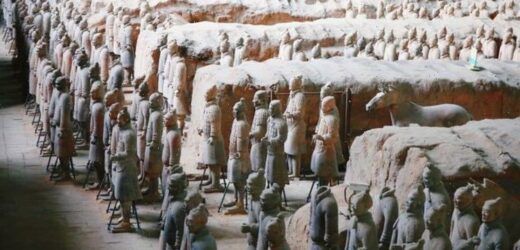Archaeologists use 3D modelling to identify 'unusual' statue
We use your sign-up to provide content in ways you’ve consented to and to improve our understanding of you. This may include adverts from us and 3rd parties based on our understanding. You can unsubscribe at any time. More info
These sculptures were discovered in a newly excavated section of a pit labelled “pit one” in the Chinese city of Xi’an, capital of northwest China’s Shaanxi Province. Archaeologists found that the figures were mainly infantry and chariots. Meanwhile, a few of the other warriors were identified as generals, owing to their more elaborate headgear.
According to a statement by Emperor Qin Shi Huang’s Mausoleum Site Museum, the painted pottery figures unearthed this time are well preserved.
Archaeologists have transported the terracotta figures to the protection and restoration room.
Reports from the China Global Television Network (CGTN) state that some of the warriors appear to be in pieces, and experts at the Emperor Qin Shi Huang Mausoleum Site Museum will restore them.
According to the CGTN, researchers found that the military array arrangement of the pit might be symmetrical from north to south and from east to west.


The report said: “This discovery is of great significance to understand and study the military array arrangement of the whole No. 1 pit.”
The pit is rectangular in shape, 230 meters long from east to west, 62 meters wide from north to south and 5 meters deep, with a total area of 14,260 square meters.
According to the estimated density of the excavation, more than 6,000 pottery figures and horses can be unearthed.
The Terracotta Army is a collection of terracotta sculptures depicting the armies of Qin Shi Huang, the first Emperor of China, who reigned from 210–209 BCE.

These life-size figures were built to protect the first emperor of China in the afterlife.
Experts believe that the army consists of 8,000 sculpted “warriors” buried inside three pits about a mile northeast of the mausoleum of Emperor Qin Shi Huang, who was the first to unify China in 221 B.C.
Of these, researchers have so far unearthed about 2,000 of these lifelike soldiers, that were buried with weapons such as crossbows, spears and swords, some of which are still intact.
Qin Shi Huang became king of Qin in 247 B.C., which was a provincial state that eventually seized control over the entire land of present day China, becoming the first emperor of the region.
DON’T MISS:
Biden humiliated as he’s ‘thrown under bus’ by Scholz and Macron [INSIGHT]
‘Food prices to rise further’ in UK as Putin BANS export of chemical [REVEAL]
Rishi turns back on PM and calls for six oil and gas fields to be fire [SPOTLIGHT]

These figures are life-sized, and typically range from anywhere between 175 cm to about 200 cm based on the soldier’s rank.
Experts are able to distinguish between the soldiers due to the variations in height, uniform and hairstyle, that different in accordance to rank.
What’s most fascinating about these figures is that their faces appear to be different for each individual figure.
However, scholars have been able to identify 10 basic face shapes.

Many of the variations lie in the uniforms of the soldiers, based on their rank.
While some terracotta figures may wear shin pads, others do not.
The body armours worn by the figures also vary depending on rank, function, and position in the army formation.
Along with soldiers, archaeologists have also found terracotta horses placed among the warrior figures.
Source: Read Full Article


